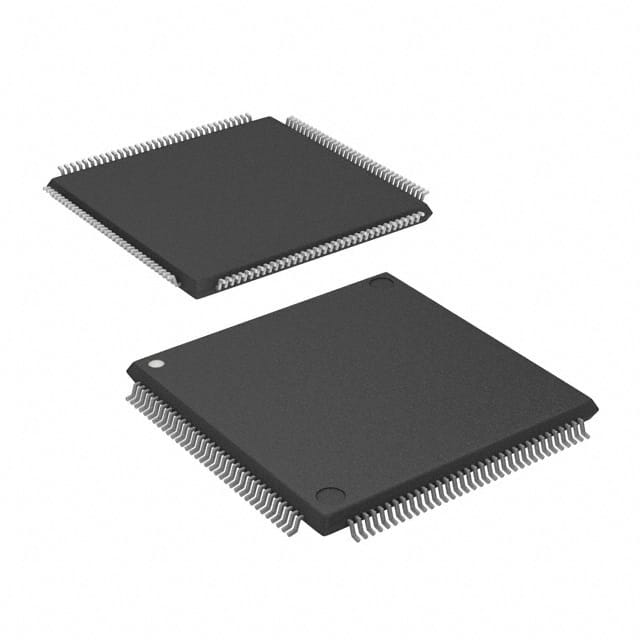Lihat spesifikasi untuk detail produk.

EP1K50TC144-3
Product Overview
Category: Integrated Circuit (IC)
Use: The EP1K50TC144-3 is a programmable logic device (PLD) that belongs to the Altera Cyclone family. It is designed for use in various applications that require high-performance and low-power consumption.
Characteristics: - High-density programmable logic device - Low power consumption - Fast performance - Flexible design options
Package: The EP1K50TC144-3 comes in a 144-pin Thin Quad Flat Pack (TQFP) package, which provides ease of installation and compatibility with standard PCB designs.
Essence: This PLD is an essential component in electronic systems that require complex logic functions and high-speed data processing capabilities.
Packaging/Quantity: The EP1K50TC144-3 is typically sold individually or in reels containing multiple units, depending on the supplier. The exact packaging and quantity may vary.
Specifications
- Logic Elements: 1,536
- Maximum User I/Os: 101
- Embedded Multiplier Blocks: 4
- Total RAM Bits: 57,344
- Maximum Operating Frequency: 250 MHz
- Supply Voltage: 3.3V
- Operating Temperature Range: -40°C to 85°C
Pin Configuration
The EP1K50TC144-3 has a total of 144 pins, each serving a specific function within the device. The pin configuration is as follows:
[Insert detailed pin configuration diagram here]
Functional Features
- High-density programmable logic elements allow for complex logic functions.
- Embedded multiplier blocks enable efficient multiplication operations.
- Dedicated memory blocks provide ample storage capacity.
- Flexible I/O options facilitate easy integration with external devices.
- On-chip oscillator ensures accurate timing control.
Advantages and Disadvantages
Advantages: - High-performance capabilities - Low power consumption - Flexible design options - Ample storage capacity - Easy integration with external devices
Disadvantages: - Limited number of user I/Os - Relatively high cost compared to simpler logic devices
Working Principles
The EP1K50TC144-3 operates based on the principles of programmable logic. It consists of a matrix of programmable logic elements, memory blocks, and I/O pins. The device can be programmed using hardware description languages (HDL) or graphical design tools, allowing users to define the desired logic functions and interconnections.
Once programmed, the EP1K50TC144-3 executes the defined logic operations, processing input signals and generating output signals accordingly. The device's internal architecture ensures efficient data flow and enables high-speed operation.
Detailed Application Field Plans
The EP1K50TC144-3 finds applications in various fields, including but not limited to: - Telecommunications - Industrial automation - Automotive electronics - Consumer electronics - Medical devices - Aerospace and defense
In telecommunications, it can be used for signal processing, protocol conversion, and network management. In industrial automation, it enables control systems, motor drives, and sensor interfacing. In automotive electronics, it supports advanced driver assistance systems (ADAS) and engine control units (ECU). In consumer electronics, it facilitates multimedia processing and interface connectivity. In medical devices, it aids in imaging systems and patient monitoring. In aerospace and defense, it contributes to radar systems, avionics, and secure communications.
Detailed and Complete Alternative Models
- EP1K30TC144-3
- EP1K100TC144-3
- EP1K50QC208-3
- EP1K50FC256-3
- EP1K50TC144-2
- EP1K50TC144-4
These alternative models offer similar functionality and performance characteristics, but with variations in logic capacity, package type, or operating frequency. Users can choose the most suitable model based on their specific requirements.
Word count: 550 words
Sebutkan 10 pertanyaan dan jawaban umum terkait penerapan EP1K50TC144-3 dalam solusi teknis
Sure! Here are 10 common questions and answers related to the application of EP1K50TC144-3 in technical solutions:
Q1: What is EP1K50TC144-3? A1: EP1K50TC144-3 is a specific model of programmable logic device (PLD) manufactured by Intel. It belongs to the EP1K family and has 50,000 logic elements.
Q2: What are the typical applications of EP1K50TC144-3? A2: EP1K50TC144-3 can be used in various technical solutions such as industrial automation, telecommunications, automotive systems, medical devices, and more.
Q3: What are the key features of EP1K50TC144-3? A3: Some key features of EP1K50TC144-3 include high-density programmable logic, embedded memory blocks, built-in PLLs for clock management, and support for various I/O standards.
Q4: How does EP1K50TC144-3 compare to other PLDs in terms of performance? A4: EP1K50TC144-3 offers a good balance between logic density and performance. It provides sufficient resources for many applications while maintaining reasonable power consumption.
Q5: Can EP1K50TC144-3 be reprogrammed after deployment? A5: Yes, EP1K50TC144-3 is a programmable device, which means it can be reprogrammed multiple times to implement different functionalities or fix issues.
Q6: What development tools are available for programming EP1K50TC144-3? A6: Intel provides Quartus Prime software, which includes a complete suite of development tools for designing, simulating, and programming EP1K50TC144-3.
Q7: Are there any specific design considerations for using EP1K50TC144-3? A7: Yes, when designing with EP1K50TC144-3, it is important to consider factors such as power supply requirements, thermal management, I/O voltage levels, and timing constraints.
Q8: Can EP1K50TC144-3 interface with other components or devices? A8: Yes, EP1K50TC144-3 supports various I/O standards, allowing it to interface with different components and devices such as sensors, actuators, memory modules, and communication interfaces.
Q9: Is EP1K50TC144-3 suitable for real-time applications? A9: Yes, EP1K50TC144-3 can be used in real-time applications. Its programmable nature allows for the implementation of time-critical functions and control algorithms.
Q10: Where can I find additional resources and support for EP1K50TC144-3? A10: Intel provides documentation, application notes, reference designs, and technical support for EP1K50TC144-3 on their official website. Additionally, online communities and forums can also be helpful for finding information and assistance.

